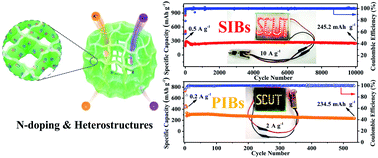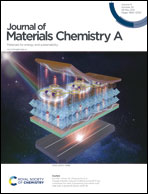Sb2O3@Sb nanoparticles impregnated in N-doped carbon microcages for ultralong life and high-rate sodium ion batteries†
Abstract
Antimony-based materials have been considered as highly competitive anodes for sodium-ion batteries (SIBs) because of their high theoretical capacity. However, the poor rate capability and fast capacity fading, originating from sluggish kinetics and volume expansion, greatly restrict their practical application. To address the above issues, an effective spraying method and one-step partial reduction process were utilized to synthesize Sb2O3@Sb nanoparticle impregnated in N-doped carbon microcages (Sb2O3@Sb@NC) offering extraordinary sodium storage capabilities and delivering an ultra-high rate performance of 175.1 mA h g−1 at 20 A g−1 and a superior capacity retention of 245.2 mA h g−1 after 10 000 cycles under 10 A g−1 for SIBs. Such unprecedented electrochemical properties of the Sb2O3@Sb@NC electrode can be ascribed to the comprehensive characteristics derived from multi-scale structural engineering: the fast electrochemical kinetics and tight packing of Sb2O3@Sb nanoparticles with carbon sheets, the strong Na+ adsorption ability of Sb2O3@Sb@NC enhanced by the synergistic effect of heterostructures and N-doping, the structural integrity strengthened by a robust interface bond of Sb–O–C, and the improved pseudocapacitive contribution. These distinct features enable the Sb2O3@Sb@NC anode to be a potential candidate for large-scale sodium ion storage.



 Please wait while we load your content...
Please wait while we load your content...